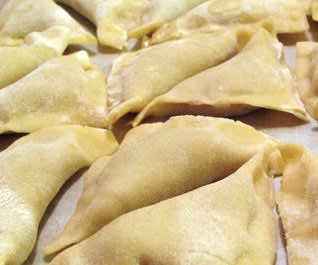
When Jayne Cohen and her sister returned home after their grandmother had passed away, they were determined to recreate the holiday dishes they had grown up on. But neither had ever attempted these traditional recipes. Those had been Grandma’s province.
“We had never thought to copy down her recipes,” Cohen lamented. “But we shared a secret suspicion that allowing her foods to vanish from our table meant losing something much greater and more vital. And we could not bear another loss.”
Together the sisters experimented with recipes, using cookbooks for inspiration, questioning and reinterpreting, just as the rabbis through the ages have questioned and reinterpreted the meanings of Biblical texts, she said.
“We decided to make foods familiar enough to taste like Grandma’s, yet still be fresh and inventive. Dishes reimagined so that they reflected our changing palates and insatiable culinary curiosity.”
That experiment led Cohen on a decades-long quest to preserve these timeless family recipes before they disappeared, while updating them with new flavor profiles.
The result is “Jewish Holiday Cooking: A Food Lover’s Classics and Improvisations” (Wiley), with nearly 300 classic and contemporary recipes for all the holidays that unite old and new traditions. In each chapter Cohen provides a history of the holiday as well as touching personal narratives chronicling her own family’s experiences and celebrations.
“You walk a fine line trying to make foods familiar enough to taste like the holidays, yet still be fresh and innovative,” said Cohen, talking to me by phone from her home in New York. “You don’t want to wind up with something very chef-y.”
“People say, how could you touch the sacred? But when you look at how Jewish food has evolved throughout the ages, as has its ritual, people are constantly using new ingredients and new techniques, which have kept the cuisine vital and the traditions vital. We’re all sophisticated these days in terms of taste – heavy food is not appealing to us – we have to keep it fresh and exciting.”
Case in point: Purim.
“Purim was one of those holidays that was very minor when we were growing up,” she recalled. “We had hamantashen and groggers in Hebrew school. But now Purim has become very cool. There are Purim parodies, and comedians like Lewis Black and the Daily Show comedians are doing these Purim rabbi-type things in their political commentaries.
“Isaac Mizrahi lives in my building, and one year the Jewish Museum did a Purim fundraiser at the Waldorf Astoria – it was a masked ball – and he did these fashion designs, Esther as a fashionista, and had all these designers that he knew submit designs.”
In adapting recipes that invoke the spirit of the holidays, Cohen fashions a chickpeas cocktail nibble for Purim. Why chickpeas?
“Esther was supposed to have eaten only pareve vegetarian food,” she explained, “grains, nuts and seeds, because the food at Ahasuerus’s court would be nonkosher, so she couldn’t have any of the meats. Supposedly all those legumes and grains kept her beautiful. That alone is a reason to indulge.”
Eating kreplach is another Purim tradition.
“Kreplach are associated with three holidays, Yom Kippur, Simchat Torah and Purim,” Cohen noted. “The filling is hidden, and to me the real reason we eat kreplach on Purim is the theme of disguise and revelation. The whole Purim story is very interesting – the whole theme of revealing yourself and coming out that goes so well with kreplach and other covered kind of foods, the truth that is hidden but will be revealed. Also, there’s the idea that God’s will was hidden, so that really ties in very neatly with kreplach.”
And how did poppy seeds come to be associated with Purim? “On some level they have been said to symbolize Haman’s fleas. Any negative things that you could heap upon Haman you would do. So we bake mohn cookies and pound cake with poppy seeds or cabbage mixed with poppy seeds and noodles.”
Hamantashen translates to “Haman’s pockets,” and the three corners have nothing to do with his hat, she revealed. “That was a Middle Ages kind of hat. The triangle could be his pockets in which he kept the lots. The whole idea of consuming your enemies is very interesting. The Sephardim eat Haman’s ears fried in syrup. The whole idea is you are consuming a part of him.”
Recently Cohen wrote an article on sweet and sour Jewish dishes and found another Purim connection. “It’s not in the book, but I realized when doing the research that a lot of Jews from different parts of the world eat sweet and sour dishes, and the whole Purim story started out sour – or bitter – and then turned sweet, so combining both tastes in a food became popular among some Jews. I love Jewish food! There’s never one single reason. Cabbage is always considered to be an antidote to drunkenness, so what could be a better food for Purim?”

Judy Bart Kancigor is the author of “Cooking Jewish: 532 Great Recipes from the Rabinowitz Family” and can be found on the web at www.cookingjewish.com.
The words of this author reflect his/her own opinions and do not necessarily represent the official position of the Orthodox Union.

